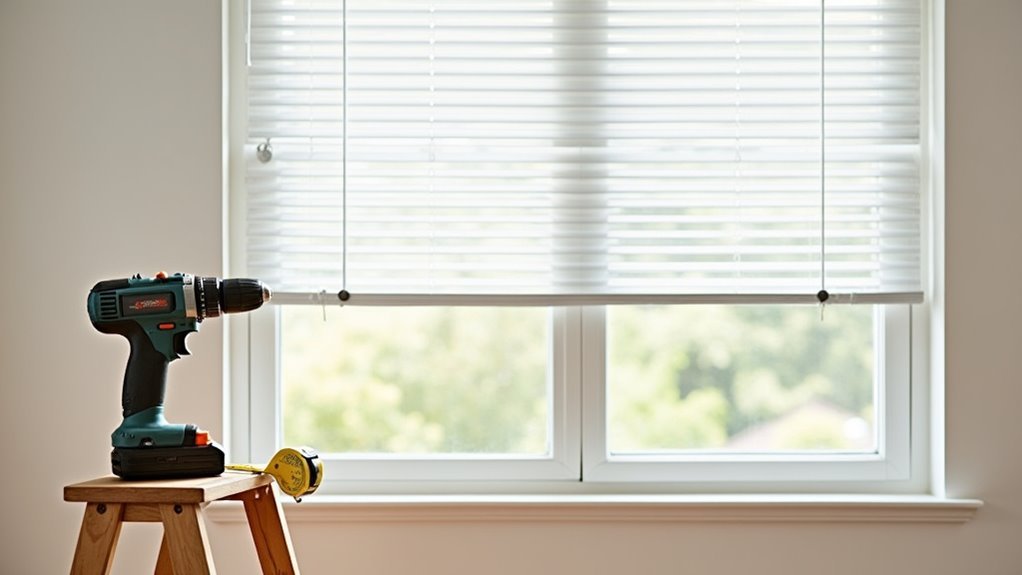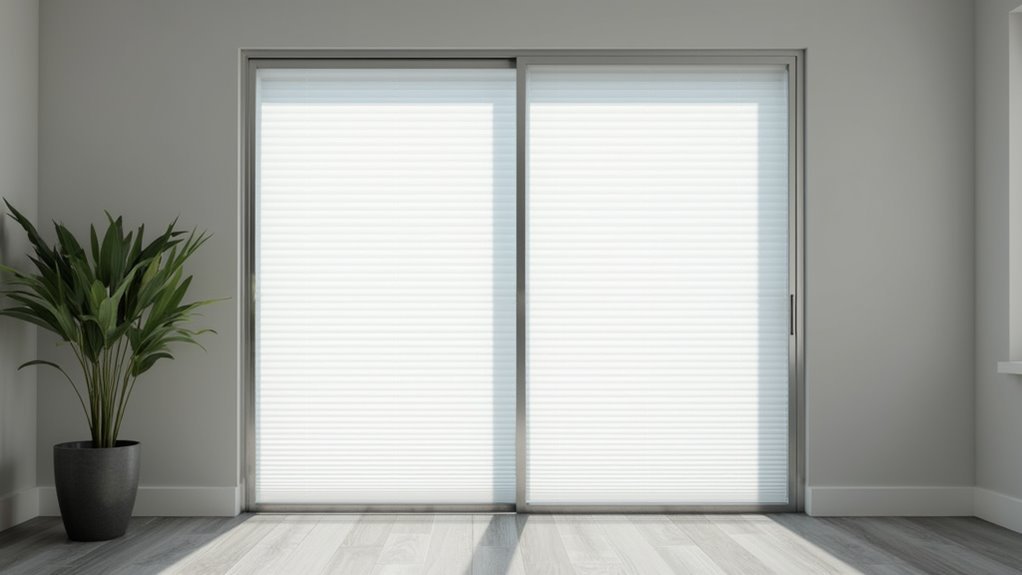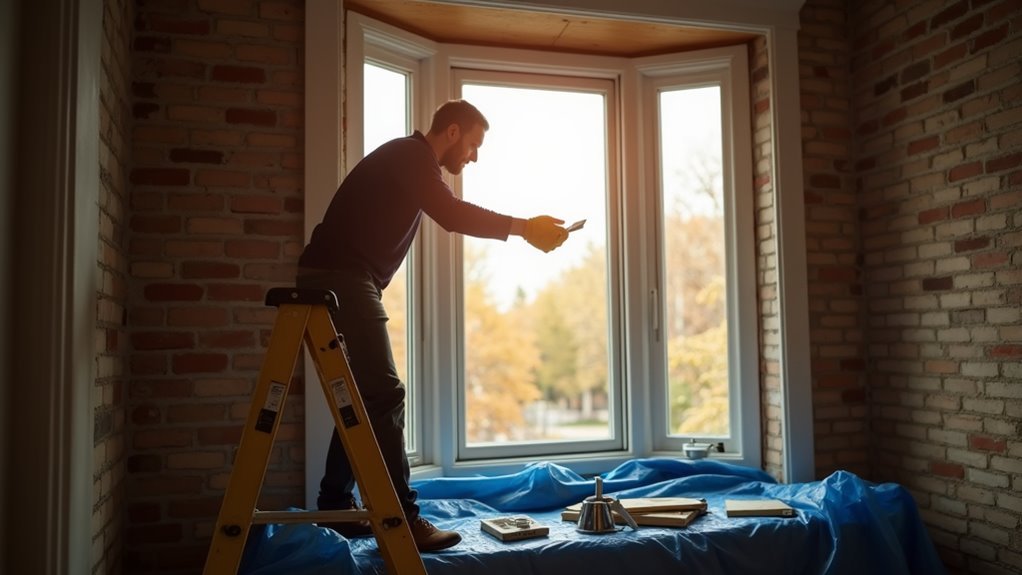To install window blinds correctly, you’ll need to follow three key steps. Initially, take precise measurements of your window at multiple points to guarantee proper fit, using the smallest measurements for inside mounts. Next, gather essential tools including a drill, level, measuring tape, and mounting hardware. Ultimately, secure the mounting brackets, attach the headrail, and test the blinds’ operation thoroughly. Following these steps carefully will help you achieve professional-quality results.
Taking Accurate Window Measurements

Two critical measurements determine the success of your window blind installation: the exact width and precise height of your window frame. When measuring, you’ll need to take into account different window styles and select appropriate measuring techniques based on your mounting preference – inside or outside the frame.
For inside mounting, measure the window opening’s width at three points: top, middle, and bottom. Use the narrowest measurement. Then measure the height at the left, center, and right sides, using the shortest measurement. For outside mounting, measure the entire area you want to cover, adding 3 inches on each side for ideal light blocking.
Always use a metal tape measure for accuracy, and double-check your measurements. Don’t deduct any amounts – the manufacturer will make necessary adjustments based on your specifications.
Gathering Essential Tools and Materials

After completing your measurements, you’ll need a specific set of tools to secure a smooth installation process. Your tool selection should include a drill with appropriate bits, a level, measuring tape, pencil, and screwdriver set. For metal or vinyl blinds, add a hacksaw to trim the headrail if needed.
Proper material preparation involves organizing your mounting brackets, screws, wall anchors, and valance clips before you begin. Check that you’ve received all components listed in your blinds’ installation manual. If you’re installing cordless blinds, verify you have the proper safety mechanisms. For wooden surfaces, pre-drill pilot holes to prevent splitting, and for drywall installation, use appropriate wall anchors rated for your blinds’ weight. Keep all small parts in a container to prevent loss during installation.
Mounting and Installing Your Window Blinds

Once you’ve confirmed your mounting location, begin by positioning the brackets according to your pencil marks. Secure them firmly using the appropriate screws, making certain they’re level and properly aligned. Different blinds types require specific installation techniques, so follow your manufacturer’s instructions carefully.
Next, insert the headrail into the mounted brackets, making sure it clicks into place securely. Test the locking mechanism before proceeding. For cordless blinds, attach the bottom rail initially, while corded varieties typically install from top to bottom. If you’re installing outside-mount blinds, you’ll need to account for extra clearance around the window frame.
Finally, test the blinds’ operation by raising and lowering them several times. Make any necessary adjustments to guarantee smooth movement and proper alignment with your window frame.
Frequently Asked Questions
How Long Do Window Blinds Typically Last Before Needing Replacement?
Your window blinds can last 7-8 years on average, but their lifespan varies based on several replacement factors. Quality materials, like aluminum or wood, may extend this to 10-15 years. To optimize longevity, follow these maintenance tips: dust weekly, clean with mild soap monthly, and avoid harsh tugging on cords. You’ll know it’s time for replacement when you notice fraying, warping, or difficulty raising and lowering the blinds.
Can Window Blinds Be Installed on Doors With Windows?
Yes, you can install window treatments specifically designed for doors with glass panels. These door blinds are made to accommodate door movement and usually mount directly onto the door frame or glass surface. You’ll find options like magnetic blinds, enclosed cellular shades, or mini blinds that won’t interfere with the door handle or swing. For the best results, choose treatments that are specifically labeled for door use to guarantee proper functionality.
Are There Child-Safety Requirements for Window Blind Installations?
Yes, there are strict child safety regulations for window blinds. You’ll need to guarantee your blinds comply with the latest safety standards, which require cordless operation or inaccessible cords to prevent strangulation hazards. If you’re using corded blinds, you must install cord cleats at least 64 inches above the floor and secure all loose cords. For maximum safety, consider cordless blinds or motorized options, especially in children’s rooms and play areas.
What’s the Average Cost to Hire a Professional for Blind Installation?
You’ll typically pay between $35-100 per window for professional blind installation, though costs vary based on your location and blind type. For a whole house, you’re looking at $350-800 on average. When comparing costs, factor in that professionals often guarantee their work and bring specialized tools. While DIY installation can save money, professional installation tips suggest hiring experts for large windows, multiple units, or complex motorized systems to ascertain proper functionality.
Can Window Blinds Be Installed on Windows With Unusual Shapes?
Yes, you can install window blinds on windows with custom shapes, but you’ll need specialized solutions. For arched, circular, or triangular windows, you’ll find specially designed blinds that can accommodate these unique configurations. However, these custom shapes often present installation challenges and may require professional expertise. You’ll typically need to order made-to-measure blinds from manufacturers who specialize in unusual window treatments, as standard blinds won’t work for these applications.






